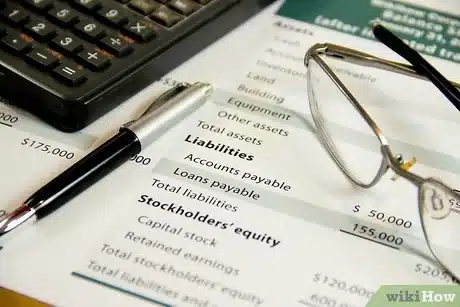Are you looking for a comprehensive guide to personal financial statements? Then you are in the right place! In this blog article, we will cover all the information you need to know about creating personal finance statements. We will explain what is a personal financial statement and the different types of personal financial statements. We will also discuss the benefits of personal financial statements and provide you with a 2023 template & example of personal financial statements.
What is a Personal Finance Statement?
A personal finance statement is a document that outlines an individual’s financial position. It is used to measure a person’s net worth by subtracting their total liabilities from their total assets. It also provides a snapshot of their financial health over a given period of time. A personal finance statement is an important tool for budgeting and financial planning.
The statement includes information about the individual’s income and expenses, as well as their assets and liabilities. It also includes information about investments, such as stocks, bonds, and mutual funds. The statement reflects the individual’s financial situation at a given point in time and provides a basis for making financial decisions.
Types of Personal Financial Statements
There are two types of personal financial statements: the balance sheet and the income statement. The balance sheet is a document that summarizes the financial position of an individual at a given point in time. It includes information about assets and liabilities, as well as the individual’s net worth. The income statement is a document that summarizes the individual’s income and expenses over a given period of time.
Benefits of Personal Financial Statements
Personal financial statements are important tools for understanding and managing your finances. They provide a snapshot of your financial health at a given point in time and allow you to track changes in your financial situation over time. This information can be used to make informed financial decisions, such as budgeting, investing, and planning for retirement.
By creating and regularly updating a personal finance statement, you can gain a better understanding of your financial situation and identify areas where you may need to make changes. This can help you make more informed decisions about your finances and reach your financial goals.
What Is the Difference Between Assets and Liabilities?
Assets are significant assets and property that can be used as collateral to secure a loan. While wages and other sources of income are not mentioned as assets, lenders will usually request to view them separately in order to acquire a better idea of your ability to manage responsibilities.
Among the common assets are:
- Savings, certificate, and money market account balances
- Investment balances include stocks, ETFs, mutual funds, bonds, annuities, life insurance cash surrender values, and commodities.
- 401(k)s and IRAs are two types of retirement funds.
- Property investment
- Vehicles, boats, jewelry, or collectibles are examples of valuable personal property.
Liabilities are accounts with a balance that must be paid off in regular installments. Monthly accumulated expenses are not included (utilities, cable, cell phone, insurance payments, rent, food, and other general living expenses). Common liabilities, on the other hand, include balances for:
- Cards de crédit
- Student Loans
- Medical expenses or taxes that have not been paid
- Mortgages or car loans
- Loans on which you have co-signed
What if Your Net Worth Is Negative?
It is a starting point, whether your net worth is positive or negative. It informs you of your present financial situation and motivates you to establish goals. The worst thing you can do is change your numbers to improve your net score. Changing amounts on an official personal financial statement on purpose is punishable by significant penalties and/or jail.
What are the 5 Basic Financial Statements?
The five basic financial statements are the balance sheet, income statement, statement of cash flows, statement of changes in equity, and statement of financial position. The balance sheet summarizes the individual’s financial position at a given point in time. The income statement summarizes the individual’s income and expenses over a given period of time. The statement of cash flows summarizes the individual’s cash flows over a given period of time. The statement of changes in equity summarizes the changes in the individual’s equity over a given period of time. The statement of financial position summarizes the individual’s assets and liabilities at a given point in time.
What are the 3 Most Common Financial Statements?
The three most common financial statements are the balance sheet, income statement, and statement of cash flows. The balance sheet provides a snapshot of the individual’s financial position at a given point in time. The income statement summarizes the individual’s income and expenses over a given period of time. The statement of cash flows summarizes the individual’s cash flows over a given period of time.
Personal Financial Statement
The balance sheet section of a personal financial statement lists the individual’s assets and liabilities, much as the balance sheet of a corporation displays all of the business’s assets and liabilities.
The Income Statement
In contrast to the balance sheet, which lists all stock variables influencing an individual’s financial status, the income statement lists all flow variables influencing an individual’s financial position.
Writing Your Personal Financial Statement
Writing a personal financial statement can be a daunting task. But with a little preparation and organization, it can be an easy process. First, you should gather all of the necessary documents and information. This includes bank statements, investment account statements, credit card statements, tax returns, and other financial documents.
Next, you should organize your documents and information into categories. This will help you create an accurate and comprehensive picture of your financial situation. Finally, you should create your personal financial statement. This should include information about your assets and liabilities, as well as your income and expenses.
2023 Template & Example of Personal Financial Statements
Creating a personal financial statement can be a daunting task. But with the right template and example, you can easily create an accurate and comprehensive picture of your financial situation. Here is a 2023 template & example of a personal financial statement to help you get started:
Assets
Cash and Cash Equivalents: $5,000 Investments: $10,000 Real Estate: $20,000
Liabilities
Credit Card Debt: $2,000 Student Loans: $5,000
Income
Salary: $70,000 Investment Income: $10,000
Expenses
Rent: $2,000 Utilities: $500 Groceries: $300
How to Use a Personal Finance Statement Template
Using a personal finance statement template can be a great way to quickly create an accurate and comprehensive picture of your financial situation. Before you start, make sure to gather all of the necessary documents and information. This includes bank statements, investment account statements, credit card statements, tax returns, and other financial documents.
Once you have all of the necessary documents and information, you can start filling out the template. Make sure to include all of your assets, liabilities, income, and expenses. Once you have filled out the template, you can use it to create an accurate and comprehensive picture of your financial situation.
How to Create a Personal Finance Statement
Creating a personal finance statement can be a daunting task. But with the right preparation and organization, it can be an easy process. First, you should gather all of the necessary documents and information. This includes bank statements, investment account statements, credit card statements, tax returns, and other financial documents.
Next, you should organize your documents and information into categories. This will help you create an accurate and comprehensive picture of your financial situation. Finally, you should create your personal financial statement. This should include information about your assets and liabilities, as well as your income and expenses.
Best Practices for Creating a Personal Finance Statement
Creating a personal financial statement can be a daunting task. But with the right preparation and organization, it can be an easy process. Here are some best practices for creating a personal finance statement:
- Gather all of the necessary documents and information. This includes bank statements, investment account statements, credit card statements, tax returns, and other financial documents.
- Organize your documents and information into categories. This will help you create an accurate and comprehensive picture of your financial situation.
- Include information about your assets and liabilities, as well as your income and expenses.
- Update your personal finance statement regularly. This will allow you to track changes in your financial situation over time.
Why Should You Utilize a Personal Financial Statement?
A personal financial statement can be a highly useful tool in financial planning. It is typically goal-oriented and can assist an individual in meeting financial objectives, particularly for young professionals entering the workforce for the first time. The majority of these folks are new to financial planning, and a basic personal financial statement is a good place to start.
When Is a Personal Financial Statement Necessary?
When applying for a business loan or other outside financing, you may be required to provide personal financial information with the finance source. Lenders want to see specifics about any personal assets you’re pledging as collateral for a loan.
Financing sources may also wish to evaluate your personal financial condition to determine how well you handle your money. For example, if you have minimal assets and a lot of outstanding debt, it may signal that you will have difficulty repaying a loan.
If you are purchasing an existing business, you may additionally want a personal financial statement. Both the business broker and the business owner will want to see proof that you can afford to buy the business.
Before approving your rental for commercial office, retail, or other forms of company space, the landlord may need a personal financial statement.
Conclusion
In conclusion, personal finance statements are important tools for understanding and managing your finances. They provide a snapshot of your financial health at a given point in time and allow you to track changes in your financial situation over time. This information can be used to make informed financial decisions, such as budgeting, investing, and planning for retirement.
Related Articles
- Why Does Accounting Matter so Much in a Business?
- Small Business Accounting UK: Best 2022 Practices & All You Need
- INCOME STATEMENT: Formats, Examples, and How To Prepare One
- HOW LONG SHOULD YOU KEEP BANK STATEMENTS: Well Explained
- PERSONAL FINANCIAL STATEMENT: Meaning, Importance & Examples






